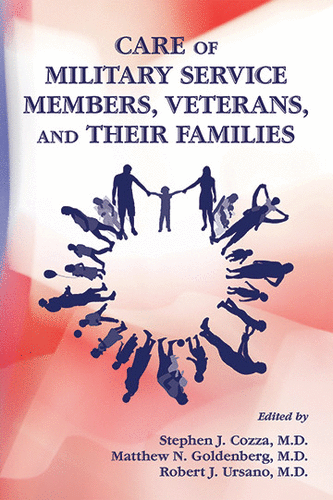Care of Military Service Members, Veterans, and Their Families

Over the past 13 years, more than two million United States military service members have been deployed to combat operations overseas, primarily in Iraq and Afghanistan. In addition to over 6,000 deaths and several thousand combat injuries, several hundred thousand service members (and their families) continue to struggle with deployment-related readjustment and medical and mental health challenges. These recent operations and their sequelae are a reminder of the longstanding issues faced by military service members, veterans, and their families in the United States and worldwide from previous wars, in addition to newly returning veterans who present new challenges in healing the wounds associated with modern warfare. The recent conflicts have also inspired significant efforts to develop new knowledge regarding treatment approaches and new systems of prevention and care delivery that are better suited to effectively support service members and their families. However, more research, infrastructure changes, and resources are required to meet current and future needs.
This book is a timely and an important milestone in the literature on the care of military members, veterans, and their families. Its strength lies in the collective expertise of its authors and editors who have produced unified and clear messages, including the message that the health and well-being of military service members and veterans is closely linked to that of their family members. The body of information about military service, culture, families, and unique challenges (such as frequent separations, relocations and deployments, changes in family roles, stigma, access to care, and injuries and deaths), as well as about the many strengths of service members (such as a sense of pride and belonging, financial stability, role flexibility, family extendedness, and resilience) is a highlight of this book. The Department of Defense and related community-based partners have made impressive progress in research, interventions, and resources in the care of military families (e.g., Child and Youth Services, Family Readiness Groups, Military OneSource, and FOCUS [Families OverComing Under Stress]) that should be widely disseminated. This aspect of this volume will help community providers better understand the needs of their service member and veteran patients and their families and is a considerable contribution to the field.
The most important conceptual contributions of this book are outlined in three fundamental factors: that combat exposure impacts mental and physical health; that deployment/combat experiences of service members are closely linked to the health and well-being of their family members; and that the military is in constant flux due to change and transitioning of members between military and civilian communities. Constant change between military and civilian communities is particularly important among National Guard and Reserve members (who constitute close to one-half of the ready force). Military members/veterans who move to the civilian sector may live in areas where there is inadequate expertise specifically related to the needs of military members/veterans and their families. Thus, the health and care of military members, veterans, and families is a national and community concern, not just a concern for the Department of Defense or the Veterans Health Administration or a few agencies. This volume’s conceptualization and focus is an excellent initial blueprint for the community to support these service members and veterans. Other strengths include the organization of this volume into three broad sections: Fundamentals for Treating Military Service Members, Veterans, and Families; Military Service-Related Conditions and Interventions; and Meeting the Needs of Military and Veteran Children and Families. This greatly helps in enhancing conceptual clarity, knowledge, and awareness for community providers with limited exposure to military members/veterans to effectively direct attention and resources toward addressing the needs of military members/veterans and their families. The chapters on Collaborative Care and Suicide in the second section are particularly impressive and informative.
The ambitiousness of this book is commendable, although there were clearly challenges in deciding what to include in this volume. The authors have negotiated this challenge quite well, striking a good balance between in-depth coverage of important topics, including theoretical and recent research advances, while also offering a lot of practical information and resources for providers. Potentially future editions of this book could expand by including an international perspective of the issues facing veterans so that we might benefit from research and practice in other parts of the world. Additional attention to the wide range of Veterans Health Administration services would be important as well (1).
The time of transition between the Department of Defense and civilian life as a veteran is one of opportunity in which returning service members can be screened, provided information about resources, and connected with services. Lack of basic needs, such as housing and employment support, can potentially exacerbate and contribute to readjustment challenges and should be addressed in conjunction with health care needs. Every Veterans Health Administration medical center has a seamless transition team that provides outreach, case management, and coordination services to support returning veterans and their families.
In summary, the experts who contributed to and edited this book have provided an important and much needed contribution to the field of military, veteran, and family care. This book will serve as an excellent resource for a wide range of medical and nonmedical service providers, increasing awareness of resources and new directions in meeting the unique needs of service members, veterans, and their families.



